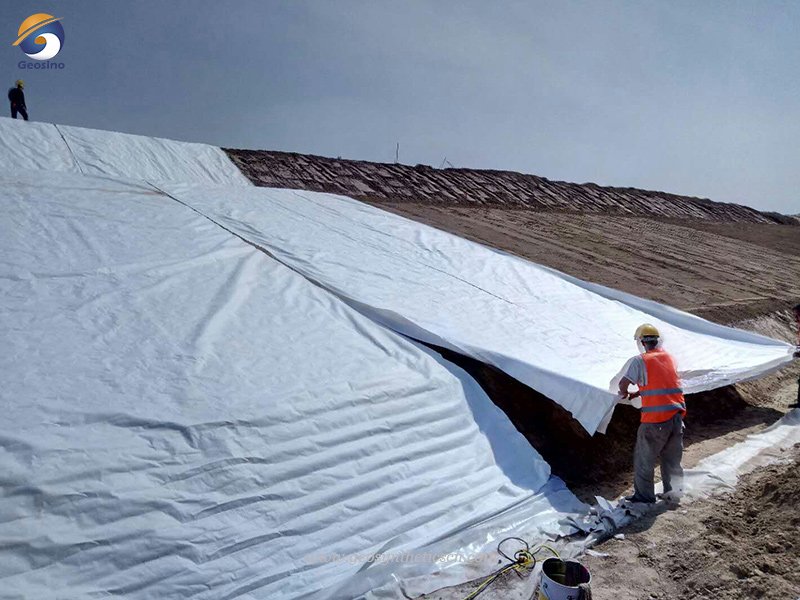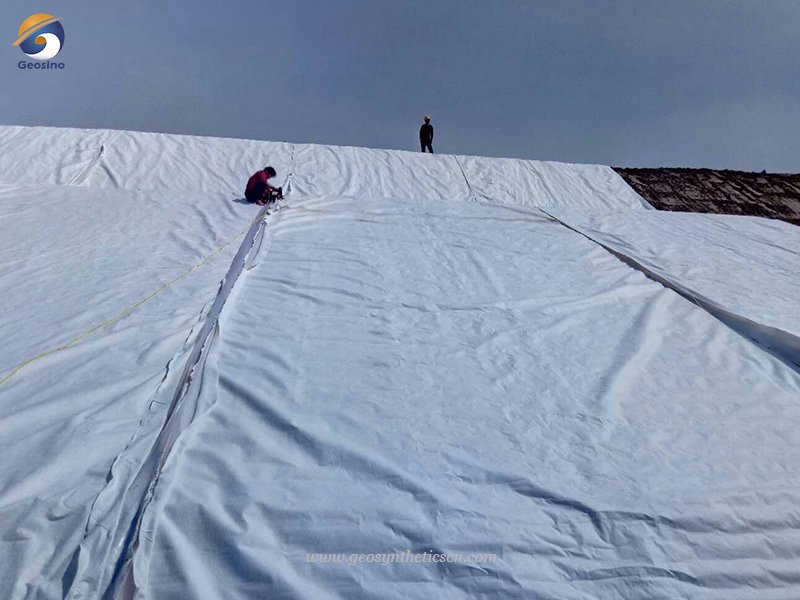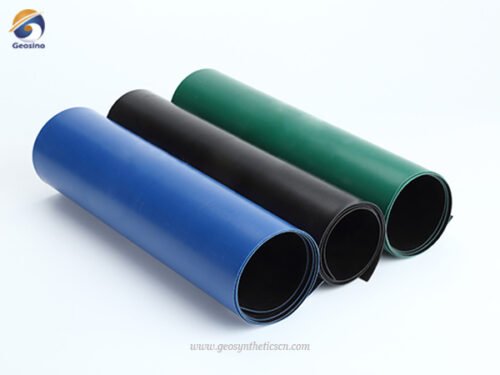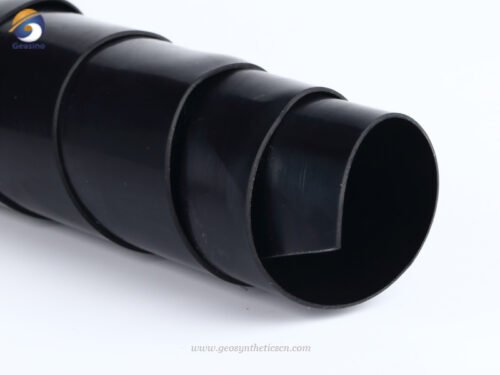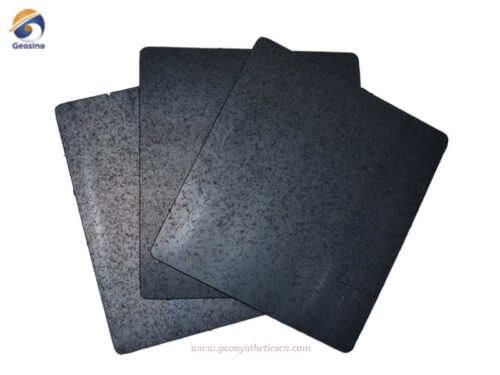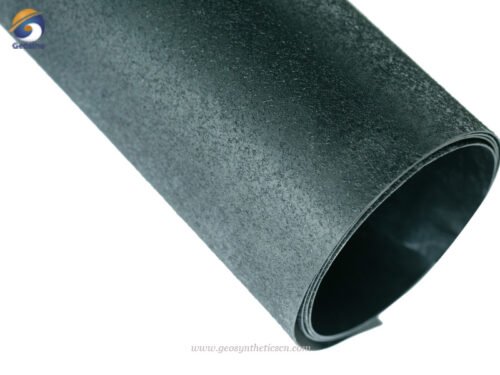- ISO9001, ISO14001, OHSAS18001 certificated factory.
- Meets or exceeds all aspects of GRI GM13.
- Excellent chemical and UV resistance.
- Excellent interface friction properties.
- Outstanding stress crack capacity.
- Complete range with width and thickness.
- Cost effective, Factory price.
- Careful robust package.
- Easy transportation, fast deployment.
- OEM/ODM Availability.
Composite Geomembrane
Description
Composite geomembrane is a combination of geotextile and geomembrane liners, creating an impermeable material. This product combines the benefits of both geomembranes and geotextiles. It is primarily utilized for anti-seepage applications in waste landfills, road construction, and fish ponds. The composite geomembrane effectively prevents the migration of liquids and provides excellent seepage control, making it an ideal solution for projects requiring reliable containment and environmental protection.
As the leading geomembrane manufacturer and supplier, GEOSINCERE offers high quality custom composite geomembrane at best factroy price.
1. What Is Composite Geomembrane?
Composite geomembrane is a geosynthetic material that combines the benefits of geotextiles and geomembranes. It consists of multiple layers bonded together to form a single unit. The geomembrane layer is typically made of materials like HDPE, LLDPE, PVC, or EPDM, providing excellent chemical resistance and durability. The geotextile layer, composed of synthetic fibers, offers added strength, puncture resistance, and filtration properties.
Composite geomembranes can be produced through thermal bonding using non-woven or woven geotextiles and HDPE geomembranes. Another method involves casting, resulting in different configurations such as one layer of geotextile and one layer of geomembrane, two layers of geotextile and one layer of geomembrane, or vice versa.
The geotextile layer acts as a protective barrier for the geomembrane, safeguarding it against damage. To enhance UV resistance and anti-aging properties, proper installation methods should be followed. During construction, a layer of sand or clay is placed on the base surface, followed by the placement of the geomembrane. The geomembrane should not be stretched tightly, and the ends should be buried with soil to allow for corrugation. A transition layer of fine sand or clay is then added, followed by a protective layer of stone or concrete blocks. Care should be taken to avoid direct impact of stones on the geomembrane, and the protective layer should be constructed on the side of the geomembrane.
Composite geomembrane liners are created by combining non-woven geotextile with smooth HDPE geomembrane liner through heat-bonding and calendaring processes. The resulting liner exhibits the advantages of both geotextiles and geomembranes. The geotextile layer enhances tensile strength, while the geomembrane layer provides impermeability, leak resistance, moisture proofing, tear resistance, and puncture resistance. With excellent quality and adaptability, composite geomembrane liners are widely used in applications such as landfills, wastewater treatment, road construction, aquaculture, landscaping, and agriculture.
2. Composite Geomembrane Liner Specifications
| Test Item | Test Properties | Unit | GSO4 | GSO5 | GSO6 | GSO7 | GSO8 |
|---|---|---|---|---|---|---|---|
| Weight | g/m2 | 400 | 500 | 600 | 700 | 800 | |
| Film Thickness | mm | 0.25-0.35 | 0.30-0.50 | ||||
| Mechanical Properties | Break Strength | kN/m | 5.0 | 7.5 | 10.0 | 12.0 | 14.0 |
| Break Elongation | % | 30-100 | 30-100 | 30-100 | 30-100 | 30-100 | |
| CBR Burst Strength | KN | 1.1 | 1.5 | 1.9 | 2.2 | 2.5 | |
| Tear Resistance | KN | 0.15 | 0.25 | 0.32 | 0.40 | 0.48 | |
| Peel Strength | N/cm | ≥6 | ≥6 | ≥6 | ≥6 | ≥6 | |
| Hydrostatic Pressure | Film Thickness | mm | 0.2 | 0.3 | 0.4 | 0.5 | 0.6 |
| One cloth one film | MPa | 0.4 | 0.5 | 0.6 | 0.8 | 1.0 | |
| Two cloth one film | MPa | 0.5 | 0.6 | 0.8 | 1.0 | 1.2 | |
3. What Are Advantages of Composite Geomembrane?
GEOSINCERE composite geomembranes offer several advantages, making them a preferred choice for various applications:
3.1 ISO Certification
Composite geomembranes are manufactured in ISO9001, ISO14001, and OHSAS18001 certified factories, ensuring high-quality production processes and adherence to international standards.
3.2 Excellent Chemical Resistance
The geomembrane component of composite geomembranes exhibits excellent resistance to various chemicals, protecting against corrosion or degradation in environments with harsh substances.
3.3 Interface Friction Properties
Composite geomembranes provide outstanding interface friction properties, ensuring stability and preventing slippage between different layers or materials, enhancing the overall performance and reliability.
3.4 Stress Crack Capacity
These geomembranes demonstrate exceptional stress crack capacity, allowing them to withstand mechanical stresses and maintain their integrity even in demanding conditions.
3.5 UV Resistance
Composite geomembranes are designed with excellent UV resistance, enabling them to withstand prolonged exposure to sunlight without degradation, ensuring long-term performance and durability.
3.6 Wide Range of Options
Composite geomembranes are available in a complete range of widths and thicknesses, offering flexibility to meet specific project requirements and ensuring optimal performance and efficiency.
3.7 Compliance with GRI GM13 Standards
Composite geomembranes meet or exceed all aspects of the Geosynthetic Research Institute’s GRI GM13 standard, ensuring high quality and reliability in their design and manufacturing.
3.8 Cost-Effective
Composite geomembranes provide a cost-effective solution for various applications. They offer competitive factory prices, making them a cost-efficient choice without compromising on quality and performance.
3.9 Robust Packaging
Careful and robust packaging ensures the protection of composite geomembranes during transportation, minimizing the risk of damage and ensuring their quality upon arrival.
3.10 Easy Transportation and Deployment
Composite geomembranes are lightweight and easy to transport, facilitating efficient logistics. They are also designed for fast deployment, enabling quicker installation and project completion.
3.11 OEM/ODM Availability
Manufacturers of composite geomembranes often offer OEM/ODM availability, allowing customization based on specific project requirements, ensuring the best fit for the intended application.
4. What Are Composite Geomembrane Used For?
Composite geomembranes have a wide range of applications in civil engineering and environmental projects. Some common uses include:
4.1 Landfill Liners
Composite geomembranes provide effective containment for waste disposal sites, preventing the migration of contaminants into the surrounding environment.
4.2 Secondary Containment Systems
They are used to create barrier systems for hazardous waste storage, ensuring protection against leaks and spills.
4.3 Mining Heap Leach Pads
Composite geomembranes are employed in mining operations to line heap leach pads, preventing the seepage of chemicals used in the extraction process.
4.4 Agricultural Pond Liners
They are used to line ponds and reservoirs in agricultural applications, preventing water seepage and ensuring efficient water management.
4.5 Decorative Pond Liners
Composite geomembranes are utilized in the construction of decorative ponds, providing a waterproof barrier and maintaining water levels.
4.6 Slope Protection
They contribute to slope stabilization by preventing erosion and controlling water seepage in embankments and steep side slopes.
4.7 Road Construction
Composite geomembranes are used as part of road construction projects to prevent water infiltration and maintain the stability of roadbeds.
4.8 Aquaculture
They are employed in aquaculture systems to line fish ponds, preventing water seepage and facilitating efficient water management.
4.9 Water Resources Protection
Composite geomembranes are used in reservoirs, canals, and irrigation systems to prevent water loss through seepage, ensuring efficient water resource utilization.
4.10 Municipal Projects
They are utilized in various municipal projects such as wastewater treatment facilities, stormwater management systems, and erosion control measures.
4.11 Mining Industry
Composite geomembranes find application in tailings dams, mine closures, and other mining-related infrastructure to prevent the release of contaminants into the environment.
5. About GEOSINCERE
GEOSINCERE has been dedicated to manufacturing wholesaling geotexitle and geosynthetics products and solutions to worldwide customers since its foundation in 2007. Our main innovative, high quality products include geotextiles, geomembranes, geogrids, geocells, geosynthetic clay liners, and drainage boards, etc al. GEOSINCERE customers are from more than 1000 countries including America, Australia, France, Sweden, UK, Hong Kong, Hungary, New Zealand, Poland, Mexico, Ecuador, Brazil, Pakistan, Bangladesh, Thailand, Vietnam, Malaysia, Indonesia, Singapore, Philippines, Sri Lanka, India, UAE, Saudi Arabia, Qatar, Kenya, Ghana, Ethiopia, Somalia, Nigeria, South Africa, Swaziland, Mongolia, etc.
GEOSINCERE offers both high quality geosynthetic products but also professional design and installation service. OEM, ODM, custom development and fabrication are also available. If you have any questions or inquiries, please contact us.





